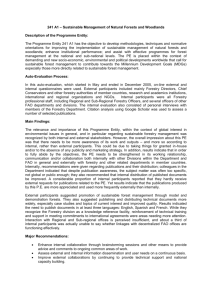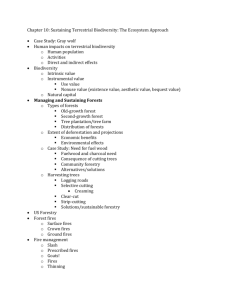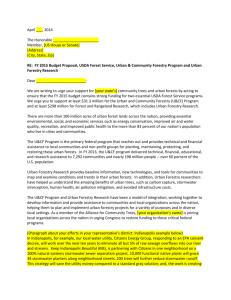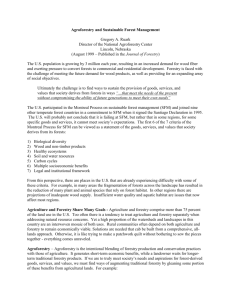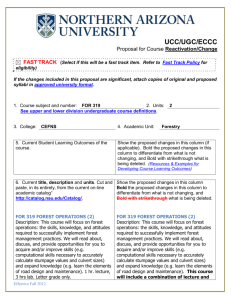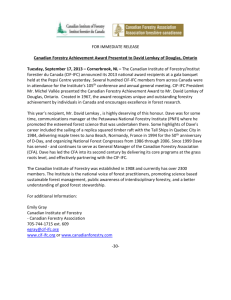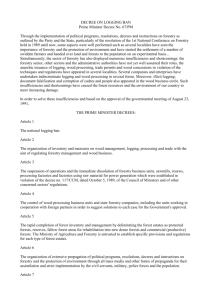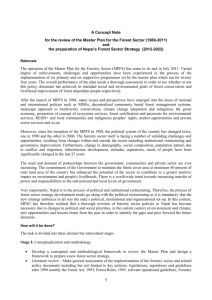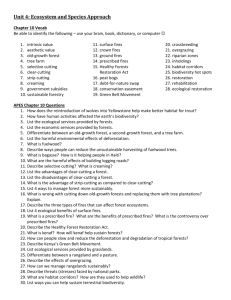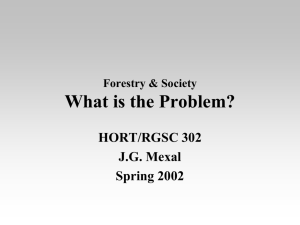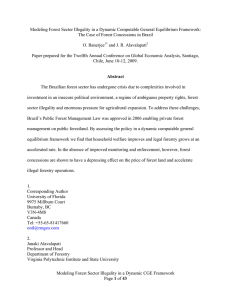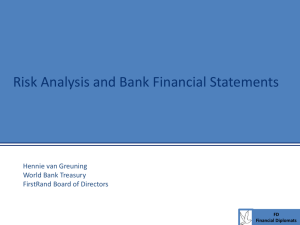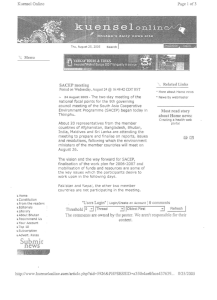Transcript - UBC Blogs
advertisement
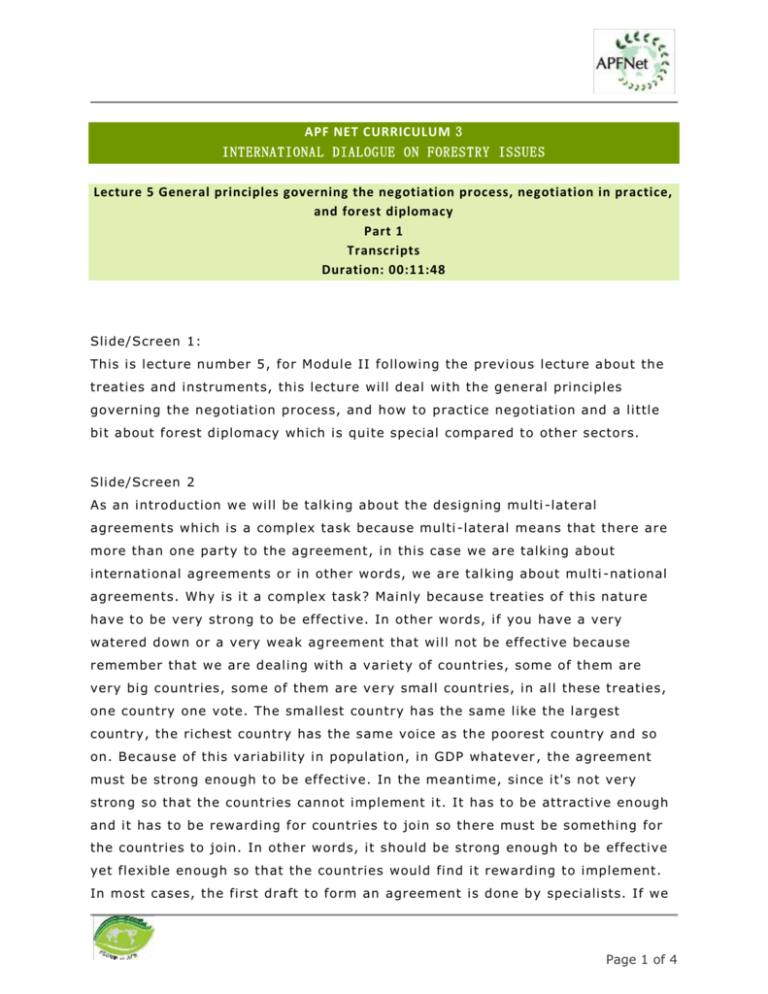
APF NET CURRICULUM 3 INTERNATIONAL DIALOG UE ON FORESTRY ISSUES Lecture 5 General principles governing the negotiation process, negotiation in practice, and forest diplomacy Part 1 Transcripts Duration: 00:11:48 Slide/Screen 1: This is lecture number 5, for Module II following the previous lecture about the treaties and instruments, this lecture will deal with the general principles governing the negotiation process, and how to practice negotiation and a little bit about forest diplomacy which is quite special compared to other sectors. Slide/Screen 2 As an introduction we will be talking about the designing multi -lateral agreements which is a complex task because multi -lateral means that there are more than one party to the agreement, in this case we are talking about international agreements or in other words, we are talking about multi -national agreements. Why is it a complex task? Mainly because treaties of this nature have to be very strong to be effective. In other words, if you have a very watered down or a very weak agreement that will not be effective because remember that we are dealing with a variety of countries, some of them are very big countries, some of them are ve ry small countries, in all these treaties, one country one vote. The smallest country has the same like the largest country, the richest country has the same voice as the poorest country and so on. Because of this variability in population, in GDP whatever , the agreement must be strong enough to be effective. In the meantime, since it's not very strong so that the countries cannot implement it. It has to be attractive enough and it has to be rewarding for countries to join so there must be something for the countries to join. In other words, it should be strong enough to be effective yet flexible enough so that the countries would find it rewarding to implement. In most cases, the first draft to form an agreement is done by specialists. If we Page 1 of 4 are having an agreement about forestry, beside the diplomats, but the general agreement or the general principles of the agreement, forget about the diplomatic language because this is a very special language but in principle it is done by specialists. Some people who kn ow forestry, who know international forestry and different aspects of it. Then when there is a draft, countries look at it and then they pass it to the diplomats to negotiate it because drafting the principles or the elements of an agreement is one thing a nd negotiating this is another thing. One is done by technicians, the other one is done mostly by diplomats and higher places like in the U.N. forum and so on. But in many cases those diplomats would refer to the respective or national technical stuff for some explanations of some points. Slide/Screen 3 When we try to develop a convention, there are some challenges in designing these international conventions, especially when we're dealing with environmental issues. What is so special about environmental i ssues? When all the nations of the world are supposed to be or are in fact sovereign nations. it means each country is independent, they can do whatever they want, it's a country, it has a status and so it has sovereignty as a country. But with this sovereignty, there is a diverse interest which makes it very complicated. Some countries for example are interested in trade, some others are interested in clean environment so they don't want anybody to cut the forests or something like that and so on. Some cou ntries are interested mainly in the welfare of their population, all countries are interested in the welfare but some are more than the others. There are some pressures inside some countries to do something that the country or the government of certain cou ntries would have to respond. On the other hand we are dealing with a very complex issue in forestry because forestry has so many dimensions from planting trees to managing the forests, to harvesting the forests, to protecting the forests and so many other things so it's a very complex thing. We cannot talk about the forest like a field of corn for example, because if you look at the field of corn these days, especially in the variety of hybrid corn, you think that it's all like a brush or the same height o r the same spacing, it's just like many clarities really clear that's not in the forest, even in forest plantation there are so many variability there. In the meantime, issues are complex. The players are diverse you have the Page 2 of 4 government officials, you have the private sector of interests, you have the local population, you have the NGOs, everybody is interested in the issue which makes it very compl ex. This is on one hand, so you have this complexity within the forestry sector and then there is a complexity of the relationship between the forestry sector and other natural resource sectors with their policies. You have a forestry policy for a certain area or a certain country or a certain location and then agriculture policy and then water policy, and energy policy and most of the times these are not really matching, Slide/Screen 4 or there's no indication between them. We come to the strategies of developing a convention. What is the strategies that the countries should have in mind when they start developing a convention and in this case we're talking in general but with special interest to forestry. Well, first of all the countries should raise awareness of the environmental concerns with global implications within the country you need to, as a country all your population or most of the population or concerned population behind you or as a government, when you go and negotiate a convention or develop it because if you say that OK we're going to talk about reducing defor estation and nobody cares in the country, that's going to be very difficult. What are the implications of continuing with deforestation or what are the implications, what are the benefits of a convention to reduce or an agreement to reduce deforestation, f or example environmental, social, economic and so on. Then we have to define the issues. What are we talking about? Is it really related to the forest as a forest? or forest within a context? Or forest and climate change or biodiversity? And we should employ or get some people to look at the facts about the subject what are the facts? When we do, there's a lot of deforestation for example, will this affect the environment? Definitely does. Where we can go to the lecture, some people will do fact finding missions. Then we have, as countries, each country will bring its own concerns and facts to the table and will start formulating the draft of an agreement and then the bargaining starts, for example you bargain about what? Negotiating, bargaining, it's not a very good word about this is actually what it is working. Like you say OK my country has been labelled as a country with a very high rate of deforestation, for example and we emit a lot as a country we emit a lot of greenhouse gases, yes. But if in order f or us to reduce our Page 3 of 4 deforestation, I'm just using an example, by 20% annually or by 10% annually, others should do the same. And other countries may say, no no, we cannot do 10%, we can do 5% and so on. This process, I'm just again using an example of deforestation but there are so many other examples for the negotiation process. And once the countries negotiate and come to a general agreement which may take years by the way, then there is a consensus and there are some within a U.N. setting with some experts around, or some diplomats and so on, there is always a consensus built through the process and then they start drafting the final text. In the final text you put all the provisions that you need to have there plus a provision for withdrawal or denunciation which means that, yes a country A or a country B, or country C , we agree these are the principles, this is the draft we are going to agree on but there must be a provision for withdrawal, if I take it back to my government, there may be some concerns, disagreement so it should be free to withdraw. If there's an agreement in my country and all the countries agree, I take it back to my capital, to my government and get the government to sign on it. It could be the prime minister, the minister, the president, whoever, the king, they sign on it. And they always say, they initiate it, it's not the final one. Then they would take it to the country authority, could be the ministry or the cabinet or ministers, whatever. They take it to the parliament to ratify it. Once ratified by the parliament, it becomes a law . And once in each agreement there is some provisions, they say OK, this agreement will go or enter into a force when say 50 countries signed it, 30 countries, 100 countries, please specify, once they re ach this number of countries, will rectify it, and the agreement enters into force and then we start the coordination of the international action and implementation, we agreed on to do something about sustainable forest management as a group of nations, as the U.N. or others, we need to coordinate our action as countries and both within the country and internationally and you start implementation. Slide/Screen 5 [End of Module II, Lecture 5, Part 1] Page 4 of 4

